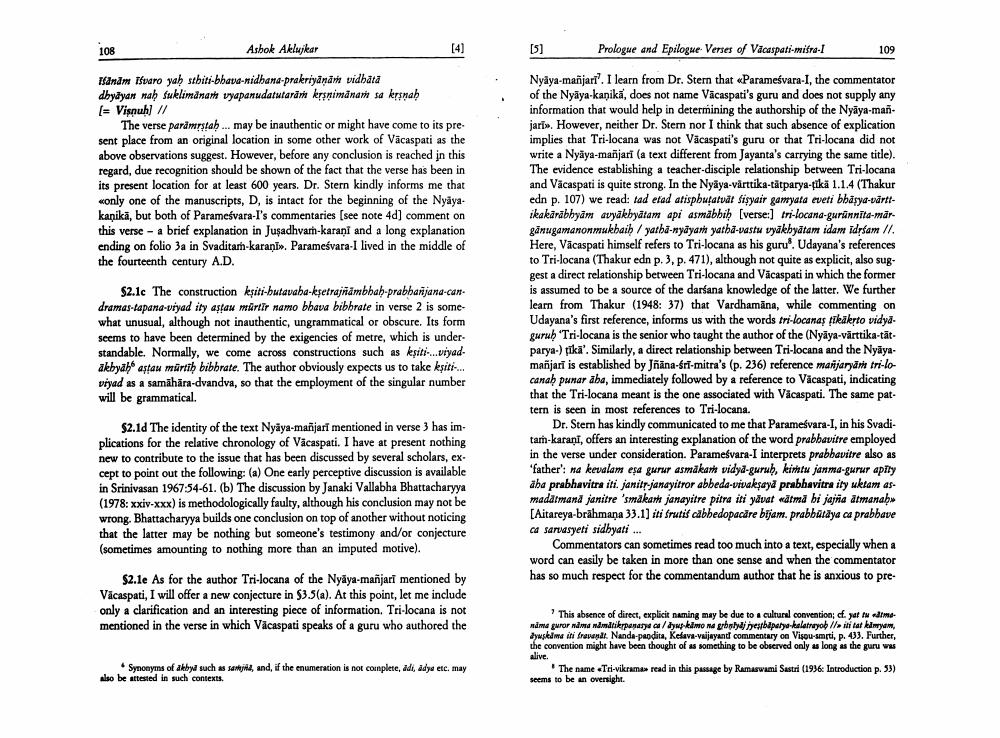Book Title: Prologue And Epilogue Verses Of Vacaspati Misra I Author(s): Ashok Aklujkar Publisher: Ashok Aklujkar View full book textPage 3
________________ 108 Ashok Aklujkar [5] Prologue and Epilogue Verses of Vacaspati-mifra.I 109 Ifandom Ifraro yah stbiti-bhava-nidhana-prakriyaņārt vidhata dbydyan nah suklimanane vyapanudatutarane krstimanante sa krsnah [= Visnuh) // The verse paramrstah... may be inauthentic or might have come to its present place from an original location in some other work of Vacaspati as the above observations suggest. However, before any conclusion is reached in this regard, due recognition should be shown of the fact that the verse has been in its present location for at least 600 years. Dr. Stern kindly informs me that wonly one of the manuscripts, D, is intact for the beginning of the Nyaya kanika, but both of Parameśvara-I's commentaries (see note 4d] comment on this verse - a brief explanation in Juşadhvar-karani and a long explanation ending on folio 3a in Svaditarh-karani.. Parameśvara-I lived in the middle of the fourteenth century A.D. S2.lc The construction besiti-butavaha-kesetrarambhah-prabharijana.com dramas-tapana-vryadity astax mürtir namo bhava bibbrate in verse 2 is somewhat unusual, although not inauthentic, ungrammatical or obscure. Its form seems to have been determined by the exigencies of metre, which is under standable. Normally, we come across constructions such as kşit.viyad. akbyah aştau mürtih bibhrate. The author obviously expects us to take kesiti... viyad as a samahara-dvandva, so that the employment of the singular number will be grammatical. Nyāya-mañjarr'. I learn from Dr. Stern that «Parameśvara-I, the commentator of the Nyāya-kanika, does not name Vācaspati's guru and does not supply any information that would help in determining the authorship of the Nyāya-manjaris. However, neither Dr. Stem nor I think that such absence of explication implies that Tri-locana was not Vācaspati's guru or that Tri-locana did not write a Nyaya-manjari (a text different from Jayanta's carrying the same title). The evidence establishing a teacher-disciple relationship between Tri-locana and Vacaspati is quite strong. In the Nyaya-virttika-tatparya-fikk 1.1.4 (Thakur edn p. 107) we read: tad erad atisputatud! Sisyair ganyata aveti bhagya-udoti ikakärabbyam avyakhyātam api asmabbih (verse:) tri-locana-gunnite-marganugamanonmukhaih/yarba-nyayani yarhd-vastu Bydkbyatan idam idosam //. Here, Vācaspati himself refers to Tri-locana as his guru. Udayana's references to Tri-locana (Thakur edn p. 3. p. 471), although not quite as explicit, also suggest a direct relationship between Tri-locana and Vacaspati in which the former is assumed to be a source of the darśana knowledge of the latter. We further learn from Thakur (1948: 37) that Vardhamana, while commenting on Udayana's first reference, informs us with the words tri-locanas takto vidyd. guruh Tri-locana is the senior who taught the author of the (Nyaya-vårttika-tätparya-) ika'. Similarly, a direct relationship between Tri-locana and the Nyüyamañjarī is established by Jñana-fri-mitra's (p. 236) reference manjaryan tri-locanah punar āba, immediately followed by a reference to Vacaspati, indicating that the Tri-locana meant is the one associated with Vicaspati. The same pat. tern is seen in most references to Tri-locana. Dr. Stern has kindly communicated to me that Paramešvara-I, in his Svaditar-karani, offers an interesting explanation of the word prabbavitre employed in the verse under consideration. Paramešvara-I interprets prabhavitre also as 'father': na kevalam esa gurur asmakan vidyd-guruh, kintu janma gurur aptly aba prabhavitra iti, janitrjanayitror abbeda-vraksaya prabhavitra ity uktam as madamand janitre smakande janayitre pitra iti yuat warmd bi jana armanab [Aitareya-brāhmaṇa 33.1) iti frutif cabbedopacdre bijam. prabbataya ca prabhave ca sarvasyeti sidbyati... Commentators can sometimes read too much into a text, especially when a word can easily be taken in more than one sense and when the commentator has so much respect for the commentandum author that he is anxious to pre $2.1d The identity of the text Nyaya-manjarf mentioned in verse 3 has implications for the relative chronology of Vacaspati. I have at present nothing new to contribute to the issue that has been discussed by several scholars, ex. cept to point out the following: (a) One early perceptive discussion is available in Srinivasan 1967:54-61. (b) The discussion by Janaki Vallabha Bhattacharyya (1978: xxiv-xxx) is methodologically faulty, although his conclusion may not be wrong, Bhattacharyya builds one conclusion on top of another without noticing that the latter may be nothing but someone's testimony and/or conjecture (sometimes amounting to nothing more than an imputed motive). $2.le As for the author Tri-locana of the Nyāya-manjari mentioned by Vacaspati, I will offer a new conjecture in $3.5(a). At this point, let me include only a clarification and an interesting piece of information. Tri-locana is not mentioned in the verse in which Vacaspati speaks of a guru who authored the This absence of direct, explicit naming may be due to cultural convention; f. ya d a nimeguror medikusanywa upimo negali per altra lluitar la hukm i fred. Nende prodita, Kelave-vaijayand commentary on Visou smrti, p. 03. Further, the convention might have been thought of something to be observed only as long as the guru w alive The name Tri-vikram read in this passage by Ramaswami Sastri (1936 Introduction p. 53) seems to be an oversight. • Synonyms of akby such as said, and, if the enumeration is not complete, adi, adya etc. may also be attested in such contexts.Page Navigation
1 2 3 4 5 6 7 8 9 10 11 12 13 14
